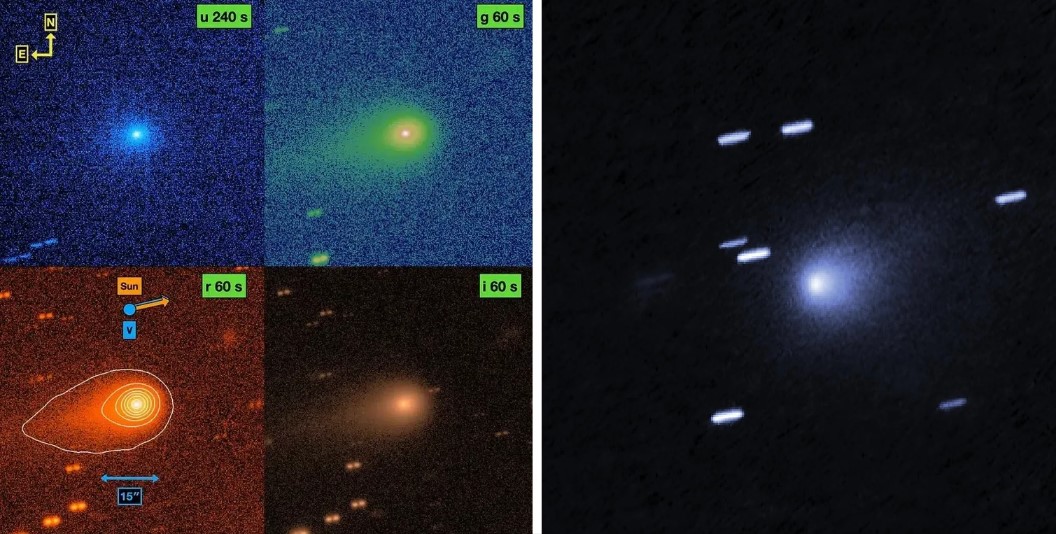NASA Confirms Anomalous Tail on Interstellar Object 3I/Atlas — Defying Known Comet Behavior

In a development that has sparked intense discussion across the scientific community, NASA has confirmed unusual behavior in the interstellar object 3I/Atlas, currently passing through our Solar System. The object, officially designated as 3I/Atlas (C/2025 N1), appears to possess a tail that bends toward the Sun — a phenomenon that contradicts everything astronomers typically observe in comets.
The confirmation came after U.S. Congresswoman Anna Paulina Luna stated that she had personally spoken with NASA officials who verified the data. According to Luna, the agency has already captured high-resolution images of the object, but they remain temporarily withheld due to the ongoing U.S. government shutdown. Once the images are released, they could provide the first clear look at a phenomenon that may redefine what scientists classify as a natural celestial object.
A Third Visitor from Beyond the Solar System
3I/Atlas is the third confirmed interstellar object ever detected, following ʻOumuamua (1I/2017) and 2I/Borisov (2019). It was first spotted on July 1, 2025, by the Asteroid Terrestrial-impact Last Alert System (ATLAS) telescope in Chile. Initial orbital calculations revealed that 3I/Atlas is on a hyperbolic trajectory, indicating that it entered our Solar System from interstellar space and will never return once it departs.
According to NASA’s Center for Near-Earth Object Studies (CNEOS), the object’s perihelion (closest approach to the Sun) occurred in late October 2025, at a distance of roughly 1.4 astronomical units — about the distance between Mars and the Sun. It will pass Earth at a safe distance of about 1.8 AU, far beyond the orbit of Mars.
The Tail That Defies Expectation
Under normal conditions, a comet’s tail always points away from the Sun, driven by solar radiation pressure and the solar wind that pushes gas and dust outward. In the case of 3I/Atlas, however, NASA scientists have observed a distinct curvature in the tail, appearing to bend toward the Sun — an orientation that defies established models of cometary physics.
Preliminary hypotheses suggest several possible explanations. One theory proposes that the object’s material composition or outgassing jets could be causing localized thrust effects, bending the tail inward. Another possibility is that interstellar dust properties or charged particle interactions unique to this object are influencing its tail’s shape.
If confirmed through imaging and spectroscopy, this would mark the first recorded instance of a comet or interstellar body exhibiting a sunward-pointing tail, forcing astronomers to reassess existing models of dust and plasma dynamics in near-solar environments.
Locked Data and Anticipation
According to Congresswoman Luna, NASA has already captured high-resolution images of 3I/Atlas through its deep-space observation network, including instruments linked to the James Webb Space Telescope and Hubble. However, these images are reportedly unreleased pending the resumption of normal agency operations after the temporary government shutdown.
In the meantime, astronomers worldwide continue to track 3I/Atlas in real time, sharing live positional and brightness data. Independent observatories have confirmed the presence of a long, asymmetric tail and a brightening coma, indicating increasing activity as the object interacts with solar radiation.
Why It Matters
The discovery of 3I/Atlas offers a rare glimpse into material that formed around another star, possibly billions of years ago. Studying its composition could provide insight into how other planetary systems evolve and how interstellar dust behaves under solar influence.
If the abnormal tail direction is verified, it could also challenge current assumptions about what defines a natural cometary object. Past interstellar visitors — such as ʻOumuamua — already sparked debate due to their unexplained accelerations and non-typical structures. 3I/Atlas’s unexpected behavior may reopen that discussion, this time with more extensive observational data.
Ongoing Investigation
NASA, the European Space Agency (ESA), and several independent observatories are now coordinating to gather multi-wavelength data on the object. Radar, optical, and infrared observations are expected to clarify whether the tail’s “sunward bend” is a physical anomaly or a geometric effect caused by our viewing angle from Earth.
While public excitement grows, scientists remain cautious. As Dr. Thomas Zurbuchen, a former NASA associate administrator, noted in a recent statement, “Interstellar objects challenge our understanding because they don’t follow our Solar System’s rules. What looks strange at first often turns out to be nature teaching us something new.”
A Cosmic Mystery in Progress
Whether 3I/Atlas turns out to be a rarely behaving comet or something more exotic, it is already reshaping how researchers approach the study of interstellar bodies. The data expected to be released after the government shutdown could offer definitive proof of the tail’s direction and composition.
Until then, telescopes around the world remain fixed on this mysterious traveler from beyond our Solar System — an object that continues to remind us how little we truly know about the universe beyond our cosmic neighborhood.
3I/Atlas isn’t just another comet — it’s a test of how far our understanding of “natural” really goes.
✍️ This article is written by the team of The Defense News.






